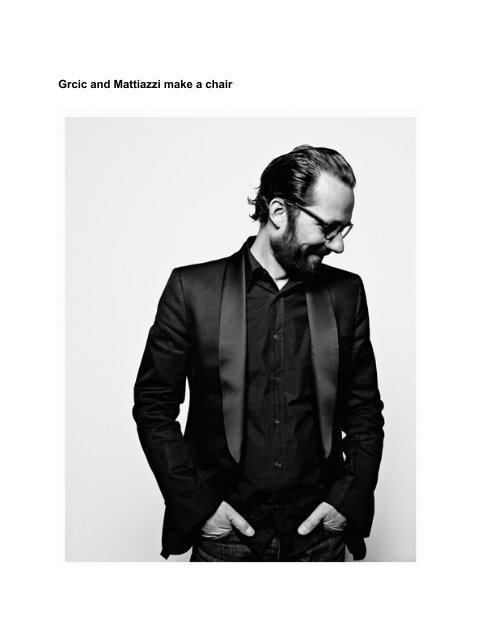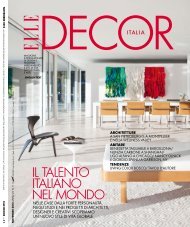Grcic and Mattiazzi make a chair
Grcic and Mattiazzi make a chair
Grcic and Mattiazzi make a chair
Create successful ePaper yourself
Turn your PDF publications into a flip-book with our unique Google optimized e-Paper software.
<strong>Grcic</strong> <strong>and</strong> <strong>Mattiazzi</strong> <strong>make</strong> a <strong>chair</strong>
Earlier this year the well-known German designer, Konstantin <strong>Grcic</strong>, designer of such iconic<br />
pieces as the Chair One for Magis <strong>and</strong> the Mayday light for Flos, released a new <strong>chair</strong> for<br />
Italian timber furniture manufacturer <strong>Mattiazzi</strong>. Not such earth shattering news as <strong>Grcic</strong> designs<br />
for numerous companies including Plank, Established & Sons, ClassiCon, Vitra <strong>and</strong> Moroso,<br />
but while many other companies release new <strong>chair</strong>s at the drop of a hat, <strong>Mattiazzi</strong> have the<br />
unusual policy of only releasing one new <strong>chair</strong> design per year (in 2012 they modified this by<br />
releasing one arm<strong>chair</strong> <strong>and</strong> one dining <strong>chair</strong>). This self consciously measured approach bucks<br />
the current trend for multiple releases. The young German designer Nitzan Cohen was trusted<br />
with the task of initiating the move from <strong>Mattiazzi</strong> the <strong>make</strong>rs of other companies designs, to<br />
br<strong>and</strong> <strong>Mattiazzi</strong> after the success of his He Said/She Said <strong>chair</strong> in 2009. Since then a small<br />
h<strong>and</strong>picked selection of designers have brought their <strong>chair</strong> ideas to life – Sam Hecht/Industrial<br />
Facility produced the Branca <strong>chair</strong> in 2010 <strong>and</strong> Ronan <strong>and</strong> Erwan Bouroullec the Osso <strong>chair</strong> in<br />
2011.<br />
The <strong>Mattiazzi</strong> workshops employ both high-tech <strong>and</strong> traditional methods<br />
<strong>and</strong> equipment.<br />
New technologies, old materials
Based in Udine in North Eastern Italy near the borders with Slovenia <strong>and</strong> Austria, <strong>Mattiazzi</strong><br />
started out as a family owned manufacturer of wooden furniture in 1978 with a reputation for<br />
producing difficult prototypes for other companies. With the workshops of <strong>Mattiazzi</strong> full of highly<br />
skilled craftsmen, it was decided that to survive in an increasingly competitive marketplace the<br />
company would have to modernise <strong>and</strong> combine the h<strong>and</strong> made bespoke abilities of it’s workers<br />
with cutting edge technology. The company installed the latest state of the art eight-axis CNC<br />
milling machines which enable the manufacture of wooden items in ways previously impossible.<br />
The equipment means that many joints are eliminated all together <strong>and</strong> timber dimensions<br />
can be reduced to the bare minimum, allowing shapes to flow in much the same way as is<br />
normally associated with moulded plastic furniture. This big picture thinking ultimately led to an<br />
environmental reappraisal <strong>and</strong> in March 2011 the company installed solar panels <strong>and</strong> insulation<br />
all over their workshop roofs <strong>and</strong> converted their winter heating to use scrap wood from their<br />
furniture manufacture. Since March 2011, the company has produced about 574,000 kwh of<br />
power <strong>and</strong> avoided around 287,000 Kg of CO2 emissions.<br />
The 'Medici' <strong>chair</strong> 3/4 view. Photo: Gerhardt Kellermann<br />
<strong>Grcic</strong> for 2012<br />
In 2012 the design baton fell to Konstantin <strong>Grcic</strong> <strong>and</strong> it was at the launch of his Medici arm<strong>chair</strong>,<br />
at Salone del Mobile in April, that I was able to talk to him about the process of designing a <strong>chair</strong>
where the stakes were so high. With only one <strong>chair</strong> per year going into production didn’t this<br />
apply quite a bit of pressure According to <strong>Grcic</strong> the only pressure was a self-imposed desire<br />
to do something completely different to the Bouroullec Brothers Osso <strong>chair</strong> of the year before.<br />
Osso had shown the abilities of <strong>Mattiazzi</strong>’s craftsmen beyond question with innovative knucklelike<br />
joints <strong>and</strong> minimal material wastage enabling the <strong>chair</strong> to be incredibly organic, as if carved<br />
by h<strong>and</strong>, yet still able to be sold at a reasonable price.<br />
<strong>Grcic</strong> on the process<br />
Working directly with a specialist, highly skilled manufacturer like <strong>Mattiazzi</strong> was quite a different<br />
method to many of <strong>Grcic</strong>’s earlier projects where br<strong>and</strong>s collaborated on the concept but<br />
outsourced the manufacture. I asked <strong>Grcic</strong> how the process worked with <strong>Mattiazzi</strong>.<br />
The 'Osso' <strong>chair</strong> by Ronan & Erwan Bouroullec launched in 2011.<br />
"When the Bouroullec’s launched the Osso in April 2011 it was already clear that we would do<br />
the next round. We started actively working on the project just before the summer (of 2011).<br />
My perception of the project is that it went quite fast but this is partly because <strong>Mattiazzi</strong> are the<br />
br<strong>and</strong> <strong>and</strong> the manufacturer, so we can deal with them direct. They can work very fast - in fact<br />
we can get the prototype back within days – normally things would have taken much longer. So<br />
it was intense – just how I like a project to be – with very direct dialogue <strong>and</strong> straight into making<br />
stuff. That made all the difference. <strong>Mattiazzi</strong> are producers - not editors who sub contract out the<br />
stuff. We would have meetings inside the factory, I could see the machinery, talk to the people<br />
who were making it <strong>and</strong> we could discuss detailing very directly. It was very enjoyable <strong>and</strong> also
very efficient".<br />
Protyping<br />
I wondered if his older method of prototyping in cardboard had reasserted itself for this project<br />
after years of intense reliance on computer design.<br />
"Recently I haven’t done much prototyping in cardboard but for this project I thought that<br />
cardboard was the obvious way to do it. We mocked things up in cardboard so I could get a firm<br />
idea of how to progress the design. Cardboard is fantastic – very fast <strong>and</strong> cheap <strong>and</strong> an easy<br />
way to build up something physical. You can then cut into it with scissors <strong>and</strong> change the shape<br />
so immediately. I could never have done this <strong>chair</strong> with computers or on a piece of paper with a<br />
pencil. It needed the physical process <strong>and</strong> for this design cardboard was the perfect prototyping<br />
tool. Often designers get very detached from the process. When designing for production in<br />
plastic for example, it’s not a machine that cuts a piece of wood - we model something on<br />
the computer <strong>and</strong> the data is sent to somebody who will mill a tool <strong>and</strong> by then everything is<br />
decided <strong>and</strong> there’s not much leverage to change things. Making things in wood is a process<br />
which is h<strong>and</strong>s on <strong>and</strong> very direct – I enjoy it much more".<br />
A cabinet <strong>make</strong>r at heart<br />
<strong>Grcic</strong> was trained as a cabinet <strong>make</strong>r before training as a designer but while many of his<br />
early designs were in wood like the Tam Tam tables for SCP <strong>and</strong> the Hut Ab for Nils Holger<br />
Moormann, his more recent work has largely revolved around more hi-tech materials. Was there<br />
a yearning to go back to simpler times<br />
"Those early projects for SCP <strong>and</strong> Moormann were very simple designs with part of the<br />
concept to <strong>make</strong> the product easy <strong>and</strong> cheap to manufacture. <strong>Mattiazzi</strong> are incredibly skilled<br />
<strong>and</strong> their production is totally sophisticated <strong>and</strong> yet I chose to do something quite simple<br />
<strong>and</strong> straightforward. If you compare my Medici <strong>chair</strong> with the Bouroullec’s Osso <strong>chair</strong> for<br />
example, mine is like a <strong>chair</strong> made of planks. I think if it wasn’t for the Osso <strong>chair</strong> I wouldn’t<br />
have designed my <strong>chair</strong> the way I did. I just thought that the Bouroullec’s had brought out the<br />
sophistication of <strong>Mattiazzi</strong>’s abilities to such an extent that I felt encouraged to actually do<br />
something very basic. For me it was nice to see the project as planks of wood cut up <strong>and</strong> not so<br />
much about shaping. It was interesting to discipline myself not to overwork the <strong>chair</strong> – despite<br />
having access to the most high tech machinery imaginable".
<strong>Mattiazzi</strong> Medici <strong>chair</strong> side on<br />
Product style<br />
With such a wide ranging style of work in his portfolio, from the rigidity of folded steel designs for<br />
ClassiCon to recent soft upholstery items for Established & Sons,<br />
I asked <strong>Grcic</strong> how the design developed once he settled on ‘basic’ as his project theme.<br />
"It is like a domino. I came after the Bouroullec’s <strong>and</strong> of course I reacted subconsciously to that<br />
– I know their <strong>chair</strong> <strong>and</strong> how it was made <strong>and</strong> of course all of that forms part of my process<br />
in making my <strong>chair</strong>. My decision to <strong>make</strong> a bigger, lower <strong>chair</strong> was one of the ideas that was<br />
present right from the beginning. I also looked at the <strong>Mattiazzi</strong> collection to date <strong>and</strong> I decided<br />
they already had plenty of pretty special dining <strong>chair</strong>s. It was nice to add a different typology<br />
to all of these <strong>and</strong> create something that stood out. Also, I don’t want to be too clever about<br />
the commercial aspect of the product but in the end it is the labour that costs, not so much the<br />
material, so making something big – the price of this <strong>chair</strong> is extremely good, I think around 800<br />
euro - ends up about the same cost as little <strong>chair</strong>s like Osso. It was something that I wanted<br />
to show <strong>Mattiazzi</strong> because they struggle a little bit with their price point in the market place. It’s<br />
always the same problem, when you <strong>make</strong> something so well, with so much care, it turns out<br />
that the price is invariably fairly high. It’s kind of frustrating that we can’t achieve a 300 euro<br />
<strong>chair</strong> but just changing the format can <strong>make</strong> a big difference to it’s perceived value. It’s a bit of a<br />
trick but it’s valid".<br />
Comfort factor
I confess to <strong>Grcic</strong> that his new <strong>chair</strong> doesn’t look that comfortable on first viewing but that it is<br />
surprisingly comfortable once you actually sit on it.<br />
"It was important for me that it had a certain comfort. There are many different ideas of what<br />
comfort is – my Model One <strong>chair</strong> for Magis isn’t the last word in comfort after all - but they don’t<br />
all have to be soft <strong>and</strong> smooth. There are <strong>chair</strong>s historically that are like this one of mine – the<br />
American Adirondack <strong>chair</strong> for example – they are so primitive, so simple, just made of planks<br />
<strong>and</strong> yet they are very comfortable because the inclination of the planks is just right. Wood is the<br />
perfect material for making furniture <strong>and</strong> it is so appropriate because you can <strong>make</strong> something<br />
simply <strong>and</strong> still <strong>make</strong> it to perfection".<br />
Timber types<br />
I quiz <strong>Grcic</strong> on why the <strong>chair</strong> is offered in Douglas Fir (or Oregon as we call it in Australia) along<br />
side the more established furniture timbers like birch, ash, oak <strong>and</strong> walnut.<br />
<strong>Mattiazzi</strong> 'Medici' <strong>chair</strong> available in Douglas Fir, American Walnut <strong>and</strong> thermo treated ash or<br />
stained either yellow or dark grey.<br />
"I had wanted to do the <strong>chair</strong> in a basic material to go with it’s design. I had wanted to do it in<br />
pine but perhaps I wasn’t courageous enough to do that, so I settled on Douglas Fir - a high<br />
end type of pine that is very beautiful <strong>and</strong> is straight grained. The other interesting timber we<br />
are offering is thermo oak. I have had samples of this in my studio for a long time <strong>and</strong> we have<br />
tried to use it in the past. The idea that it can be used outside is great but this material has<br />
disadvantages – it is so dry it becomes quite weak or brittle in thin sections - particularly around
joints. You couldn’t <strong>make</strong> the Osso <strong>chair</strong> out of it but the Medici <strong>chair</strong> has a construction method<br />
that lends it self to using it <strong>and</strong> the design of the <strong>chair</strong> is logical for use outdoors".<br />
The Medici <strong>chair</strong>s in yellow <strong>and</strong> grey stain options. Photo: Gerhardt Kellermann<br />
In terms of distribution in Australia, <strong>Mattiazzi</strong> has done the rounds – first with Corporate Culture,<br />
then Dedece but more recently Herman Miller have obtained the license for world distribution<br />
<strong>and</strong> the range is now available through Living Edge. While <strong>Mattiazzi</strong>’s limited output may have<br />
led to it’s releases being somewhat lost in the hoopla of constant multiple releases from bigger<br />
companies in the past, the distribution by Herman Miller will hopefully address this. What<br />
<strong>Mattiazzi</strong> produces is quite extraordinary <strong>and</strong> the way their products are made should be a<br />
lesson to other manufacturers world wide.





